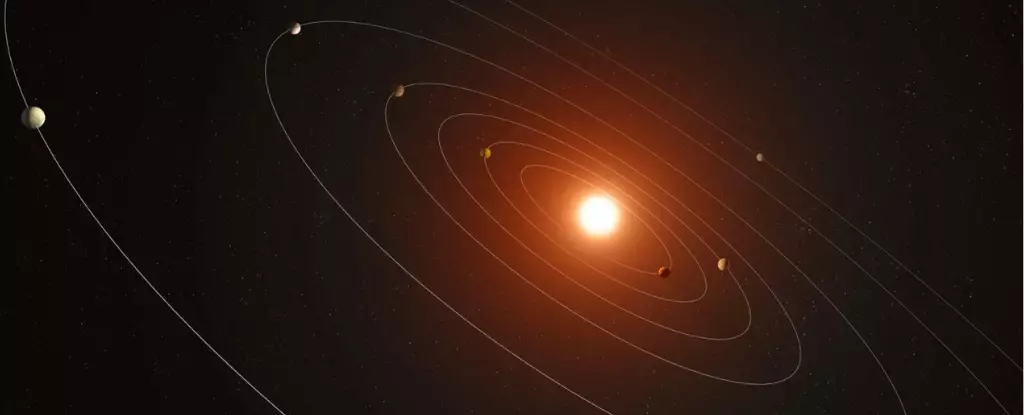NASA’s Kepler mission, spanning over nine productive years, came to an end in 2018. During its mission, the Kepler space telescope made significant discoveries, detecting thousands of planets that continue to fascinate scientists. However, the wealth of data collected by the mission is still being meticulously analyzed. Recently, a team of researchers unveiled new revelations about a seven-planet system within Kepler’s vast ocean of data. Kepler 385, a star positioned approximately 4,670 light-years away, takes the center stage in this comprehensive analysis. With some planets confirmed in 2014, others remained as potential candidates until now. By updating the catalogue, the team of exoplanet scientists has now officially confirmed the remaining planets and shared fresh insights on this unique system. The study, titled “Updated Catalog of Kepler Planet Candidates: Focus on Accuracy and Orbital Periods,” will soon appear in the Journal of Planetary Science. Leading this research is Jack Lissauer, a research scientist at NASA’s Ames Research Center.
Although the existence of the Kepler 385 planetary system has been known for quite some time, refined methods and data have allowed scientists to gain a deeper understanding and make new discoveries. This updated catalogue comprises a comprehensive list of all confirmed Kepler planet candidates that orbit and transit a single star. Among these, Kepler 385 holds significant intrigue, as it is home to seven planets in close proximity to their star, subjecting them to an intense heat bath. All seven planets are larger than Earth but smaller than Neptune. The star itself, Kepler 385, bears similarities to our Sun, albeit being slightly larger and hotter. It represents an exceptional rarity among stars, hosting more than six planets or planet candidates in its orbit. The two innermost planets bear a resemblance to Earth, being marginally larger in size. According to the updated catalogue, these planets are likely rocky with the possibility of having thin atmospheres. In contrast, the remaining five planets have radii approximately double that of Earth and probably boast thick atmospheres.
Jason Rowe, co-author and Canada Research Chair in Exoplanet Astrophysics and Professor at Bishop’s University in Quebec, Canada, highlighted that this revision of the Kepler Exoplanet catalogue delivers a cohesive analysis of exoplanet properties. These advancements in understanding allow scientists to undertake an in-depth study of the fundamental characteristics of exoplanetary systems. Moreover, they serve as a means to compare these distant worlds to our own Solar System and closely examine individual systems like Kepler 385.
The significance of the updated Kepler catalogue extends beyond the Kepler 385 system. The catalogue encapsulates nearly 4,400 planet candidates and 700 multi-planet systems, providing a rich array of research opportunities. Leveraging improved measurements of the host stars, especially from the European Space Agency’s Gaia star-measuring spacecraft, the team of researchers conducted a detailed analysis of the distribution of transit durations. These durations, which play a crucial role in probing exoplanet distributions, involve orbital eccentricities ranging from circular to highly elongated orbits. In the absence of sufficient data to measure eccentricities individually, the researchers developed methods to characterize the distribution of eccentricities across a population of transiting exoplanets. This aspect holds immense importance in the updated Kepler catalogue and led to intriguing conclusions. Notably, the researchers demonstrated that systems with more transiting planets exhibit more circular orbits, challenging previous studies that relied on complex models.
While the Kepler 385 system boasts seven planets positioned within the habitable zone, their chances of supporting life are slim. These planets are subjected to intense radiation, receiving more heat per unit area from their star than any planet in our Solar System. However, this updated work focuses primarily on presenting a more detailed and accurate Kepler catalogue, eschewing questions of habitability. As the authors mention, despite more than a decade since Kepler ceased its collection of data, the catalogue still stands as the most comprehensive and homogeneous collection of exoplanets known to date.
Thanks to NASA’s Kepler mission, the scientific community has gained profound insights into the vast exoplanet population. With the recent updates and refinements to the Kepler catalogue, astronomers now possess a more precise understanding of the properties and characteristics of countless exoplanets. As scientists continue to analyze this wealth of data, the potential for further discoveries and developments seems limitless. The updated Kepler catalogue holds the promise of unveiling deeper secrets and helping reconcile distant worlds with our own.



Leave a Reply